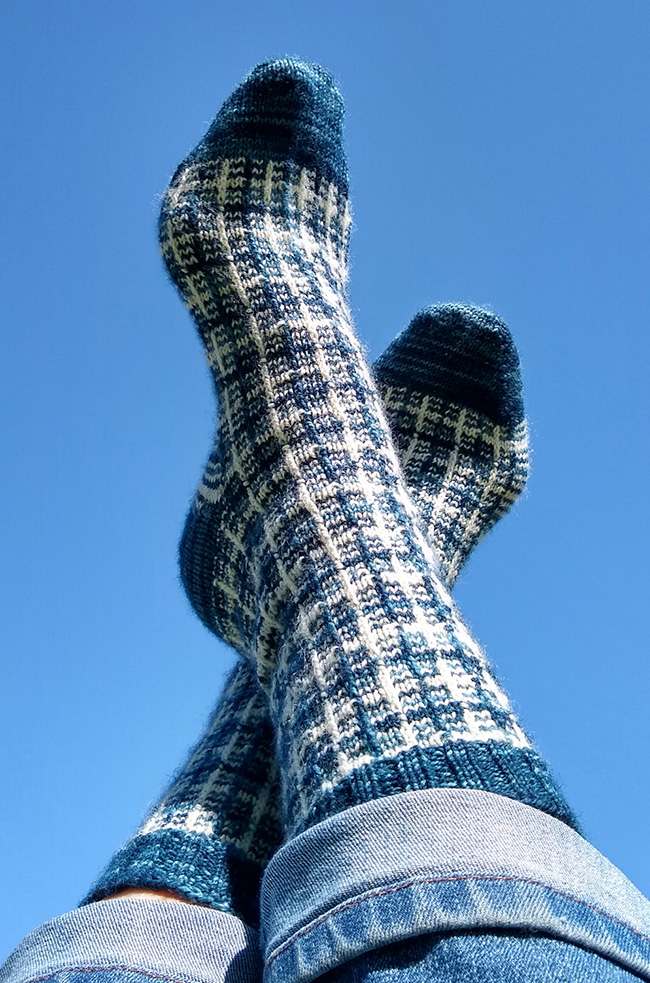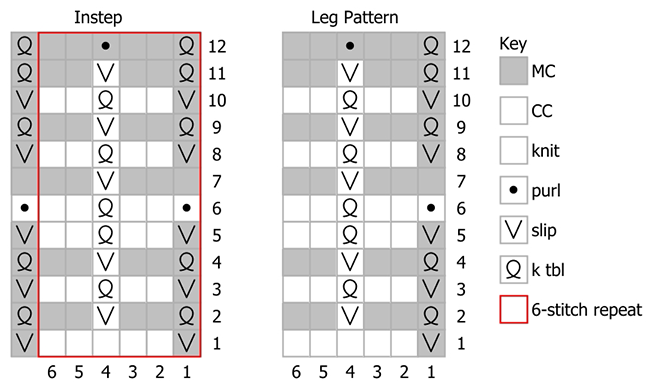Peerie Plaid, a free knitting pattern from Knitty.com.
INTRODUCTION
Peerie Plaid

by Sharon Barnes
![]()
Plaid never goes out of style! That timeless and beloved woven fabric technique was the inspiration for these socks, and this pattern is a loose translation of the plaid design concept into a small-scale knit. 'Peerie' is a word from the Shetland Islands dialect, meaning small or tiny.
The stitch pattern uses two colors, and thanks to a few slipped stitches, only one color is used at a time. Twisted stitches emphasize the vertical elements, and occasional purls at color crossings echo a tartan's twill. It looks complex, but is actually easy to memorize and work. Stockinette stitch stripes provide a smooth and comfortable sole.
Depending on your sock size and yarn supply, there may be enough yarn left over to knit a second pair by switching the main and contrast colors.
 photos: Sharon Barnes
photos: Sharon Barnes
SIZE
Adult XS[S, M, L, XL]
FINISHED MEASUREMENTS
Foot circumference: 7[7.5, 8, 8.5, 9] inches/ 18[19, 20.5, 21.5, 23] cm
Leg length: Adjustable to preference; 6 inches/15.5 cm as shown
Choose a size approximately 1 inch/2.5 cm smaller around than circumference of your foot measured at the ball of the foot.
MATERIALS
Yarn
KnitPicks Hawthorne Fingering [80% Fine Superwash Highland Wool/20% Nylon; 357 yd/326 m per 100g skein];
![]() [MC] Northstar Kettle; 1 skein (all sizes)
[MC] Northstar Kettle; 1 skein (all sizes)
![]() [CC] Bare; 1 skein (all sizes)
[CC] Bare; 1 skein (all sizes)
Yarn Characteristics
![]() This pattern looks best using a plied sock yarn with a tight twist. For a balanced color pattern, yarns should be of equal thickness. See introduction for tips on choosing colors.
This pattern looks best using a plied sock yarn with a tight twist. For a balanced color pattern, yarns should be of equal thickness. See introduction for tips on choosing colors.
Recommended needle size
[always use a needle size that gives you the gauge listed below - every knitter's gauge is unique]
![]() US #1/2.25 mm needles; your preferred needles for working small circumference in the round
US #1/2.25 mm needles; your preferred needles for working small circumference in the round
Notions
![]() 18 inches/45 cm of smooth waste yarn for provisional cast on (cotton works well)
18 inches/45 cm of smooth waste yarn for provisional cast on (cotton works well)
![]() 2 stitch markers
2 stitch markers
![]() yarn needle
yarn needle
GAUGE
32 sts/48 rounds = 4 inches/10 cm in stockinette stitch
36 sts/56 rounds = 4 inches/10 cm in pattern stitch
PATTERN NOTES
[Knitty's list of standard abbreviations and techniques can be found here.]
Construction method: These socks are knit toe-up, beginning with a provisional cast on, and feature a gusset to improve the fit of the short-row heel. Gusset stitches are decreased in the MC heel section before resuming the stitch pattern, which is then continued around the entire leg.
Suggested color pairings include two solid colors, or one solid with a semi-solid, gradient or multicolored yarn. Just make sure the hue of the solid yarn is not included in the multicolor yarn, or the design will be lost in those areas! Knitting socks in school or team colors would almost guarantee their wear on game days. Choose yarns with high-contrast colors so the stitch pattern will stand out, or you may prefer medium contrast for a more subtle effect. If in doubt, take a picture of both yarns (or better yet, a test swatch) and convert the photo to black and white to help you decide (see example below).
When changing colors, pick up the new color from underneath the color just used; do not twist colors at the beginning of the round. Take care not to over-tighten the first stitch in a new color.
Tips on working the short rows:
- short rows: photo tutorial | video tutorial
- When working short rows in the second half of toe and heel, after you've turned your work and slipped the knit- or purled-together stitch and wrap, tug on the yarn to keep the stitches tight and tidy.
- There are several ways to pick up the wraps and work them together with the wrapped stitches, this is the method I prefer: slip the wrapped stitch to the right needle, pick up wrap with left needle, return slipped stitch back from right to left needle. On RS, knit the stitch and its wrap together through the back loop. On WS, purl the stitch and its wrap together.
- Slipping sts: all stitches should be slipped purlwise with the yarn held to the WS of the work.
- If there are any gaps in the gusset decrease section, pick up the strand between the two sts below, twist and place on L needle, then k tog with the following stitch.
Techniques:
- Provisional cast on: photo tutorial | video tutorial
- Jeny's Surprisingly Stretchy Bind Off
CHARTS

Instep pattern
Rnd 1: Using CC, [Sl1, k5] 5[5, 5, 6, 6] times, sl1.
Rnd 2: With MC, [K1 tbl, k2, sl1, k2] 5[5, 5, 6, 6] times, k1 tbl.
Rnd 3: With CC, [Sl1, k2, k1 tbl, k2] 5[5, 5, 6, 6] times, sl1.
Rnd 4: With MC, rep Rnd 2.
Rnd 5: With CC, rep Rnd 3.
Rnd 6: Continuing with CC, [P1, k2, k1 tbl, k2] 5[5, 5, 6, 6] times, p1.
Rnd 7: With MC, K3, [sl1, k5] 4[4, 4, 5, 5] times, sl1, k3.
Rnd 8-11: Repeat Rnds 3-4 twice.
Rnd 12: Continuing with MC, [K1 tbl, k2, p1, k2] 5[5, 5, 6, 6] times, k1 tbl.
Leg pattern:
Rnd 1: Using CC, [Sl1, k5] around.
Rnd 2: With MC, [K1 tbl, k2, sl1, k2] around.
Rnd 3: With CC, [Sl1, k2, k1 tbl, k2] around.
Rnd 4: With MC, Rep Rnd 2.
Rnd 5: With CC Rep Rnd 3.
Rnd 6: Continuing with CC, [P1, k2, k1 tbl, k2] around.
Rnd 7: With MC, K3, [sl1, k5] to last 3 sts, sl1, k2.
Rnd 8-11: Repeat Rnds 3-4 twice.
Rnd 12: Continuing with MC, [K1 tbl, k2, p1, k2] around.
DIRECTIONS
Toe
Using your preferred provisional method and waste yarn, CO 28[30, 32, 34, 36] stitches; join MC as required.
First half of toe:
Row 1 [WS]: P.
Row 2 [RS]: K to last st, w&t.
Row 3: Sl1, p to last st, w&t.
Row 4: Sl1, k to st before last wrapped st, w&t.
Row 5: Sl1, p to st before last wrapped st, w&t.
Repeat Rows 4-5, working one less stitch each row before the next w&t, until there are 10[10, 12, 12, 12] unwrapped center stitches and 9[10, 10, 11, 12] wrapped sts on each side, ending with a WS row.
Second half of toe:
Row 1 [RS]: Sl 1, k to first wrapped stitch, work wrapped stitch together with its wrap, turn,
Row 2 [WS]: Sl 1, p to first wrapped stitch, work wrapped stitch together with its wrap, turn.
Repeat these two rows until all 28[30, 32, 34, 36] sts have been worked.
Final toe row [RS]: Sl 1, k across.
Undo provisional CO and place the 28[30, 32, 34, 36] sts on your needles. 56[60, 64, 68, 72] sts total.
K across these new sts, and then knit 1 round, until you get to 2[1, 1, 2, 1] st(s) before previous start of round. This position is the new start of round, and will be the start of the instep. First 31[31, 31, 37, 37] sts form the instep; rem 25[29, 33, 31, 35] sts form the sole; rearrange sts as you prefer.
Foot round: Work instep pattern across 31[31, 31, 37, 37] sts from chart or written instructions; k to end of round.
Continue in pattern as set until total length is 5[5.5, 6, 6.5, 7] inches/ 13[14, 15, 16.5, 18] cm OR 2[2.25, 2.5, 2.5, 2.75] inches/ 5[5.5, 6.5, 6.5, 7] cm less than desired foot length, measured from tip of toe up the center of the sole.
Make a note of the pattern row number at this measurement so you can begin the gusset at the same place on the second sock.
Gusset
Rnd 1: Work across instep in pattern as set; M1L, place inc marker, k to last st, place inc marker, M1R. 2 sts increased.
Rnd 2: Work across instep in pattern as set; k to end of round.
Rnd 3: Work across instep in pattern as set; M1L, k to last st, M1R. 2 sts increased.
Rnd 4: Work across instep in pattern as set; k to end of round.
Repeat Rounds 3-4, 3[3, 4, 4, 4] more times, until there are 5[5, 6, 6, 6] increased gusset sts on each side. The heel will be worked on the 25[29, 33, 31, 35] sole sts between the markers. 66[70, 76, 80, 84] sts total.
If the next rnd is a CC rnd, work that rnd in patt as est, then beg heel with next MC rnd, otherwise proceed straight to Short-row heel.
Short-row heel
Do not break CC yarn; you will pick it up after completing the heel.
First half of heel:
Row 1 [RS]: With MC, work across instep in pattern as set, k across heel sts to the stitch before second gusset marker, w&t.
Row 2 [WS]: Sl1, p to the st before first gusset marker, w&t.
Row 3 [RS]: Sl1, k to st before last wrapped st, w&t.
Row 4 [WS]: Sl1, p to st before last wrapped st, w&t.
Repeat Rows 3-4, working one less stitch each row before the last w&t, until there are 11[11, 13, 11, 13] unwrapped center stitches, ending on WS with 7[9, 10, 10, 11] w&t sts on each side.
Second half of heel:
Row 1 [RS]: Sl1, k to first wrapped stitch, work wrapped stitch together with its wrap, turn.
Row 2 [WS]: Sl1, p to first wrapped stitch, work wrapped stitch together with its wrap,, turn.
Repeat Rows 1-2 until all 25[29, 33, 31, 35] heel sts have been worked, ending with WS row.
Gusset decreases:
Row 1 [RS]: Sl1, k 23[27, 31, 29, 33] , to 1 st before the marker; slip that stitch, remove the marker, return the slipped st back to left needle, and work ssk on last heel st and first gusset st, turn. 1 gusset st decreased.
Row 2 [WS]: Sl1, p 23[27, 31, 29, 33] , to 1 st before the marker; slip that stitch, remove the marker, return the slipped st back to left needle, and work p2tog on last heel st and first gusset st, turn. 1 gusset st decreased.
Row 3 [RS]: Sl1, k 23[27, 31, 29, 33] , ssk, turn. 1 gusset st decreased.
Row 4 [WS]: Sl1, p 23[27, 31, 29, 33] , p2tog, turn. 1 gusset st decreased.
Rep these last two rows 1[3, 3, 2, 1] more times. 60[60, 66, 72, 78] sts.
Final heel row [RS]: Sl1, k across to start of round.
Leg
Using CC for next rnd, resume patt where you left off.
Leg round: Work Leg pattern around, from chart or written instructions as you prefer.
Work in pattern until leg measures 5[5, 5.5, 5.5, 5.5] inches/ 12.5[12.5, 14, 14, 14] cm from top of heel, or to 1 inch/2.5 cm less than desired length, ending with row 6 or 12.
Break CC.
Knit 1 round.
Ribbing round: [K2, p2] around.
Work ribbing as set for 1 inch/2.5 cm, or desired length.
BO using Jeny's Surprisingly Stretchy method, or your preferred stretchy method.
FINISHING
Cut yarn, weave in ends and trim excess. Hand wash and lay flat to dry.
ABOUT THE DESIGNER
 Sharon Barnes is a long-time spinner and knitter who enjoys starting a project with raw wool – but she also cheats and buys yarn. Her work has been published in Spin Off and in Shuttle, Spindle & Dyepot. She lives on the Kansas prairie with her husband (also of Scottish descent), rabbits, and Italian Greyhound.
Sharon Barnes is a long-time spinner and knitter who enjoys starting a project with raw wool – but she also cheats and buys yarn. Her work has been published in Spin Off and in Shuttle, Spindle & Dyepot. She lives on the Kansas prairie with her husband (also of Scottish descent), rabbits, and Italian Greyhound.
Find her on Ravelry.
Pattern & images © 2024 Sharon Barnes